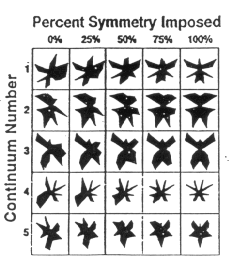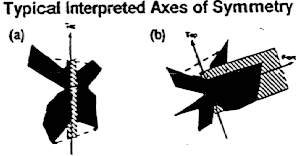Abstract
Four experiments were performed to explore assumptions viewers make in judging identity and orientation of indeterminate shapes. Subjects viewed symmetric and asymmetric random polygons and described (what the figure looks like) and its orientation. Viewers were found to almost universally interpret the shapes as silouettes of 3-D bilaterally symmetric objects. The assumption of 3-D symmetry generally constrained specified vantage so that symmetric shapes were interpreted as front or top views, and symmettric shapes as profile or oblique views. The interpretations were consistent with the notion that most salient objects or their prototypes are bilaterally symmetric. The assumption that indeterminate shapes depict symmetric 3-D objects appears to be a frequently used pattern-recognition heuristic.
Continuum: Stimuli: Experiment 4






